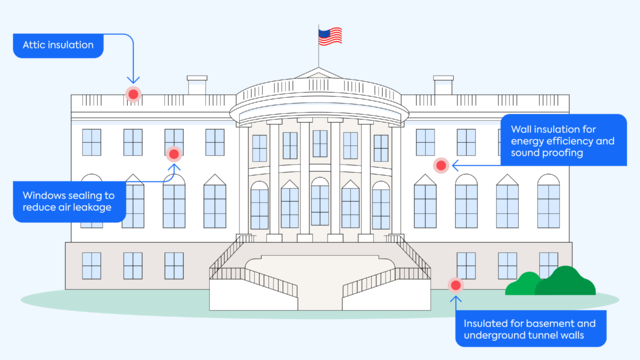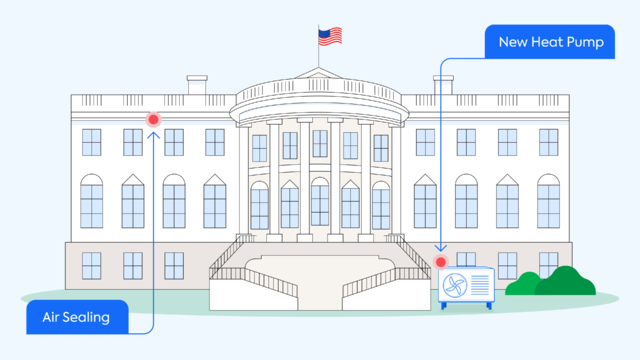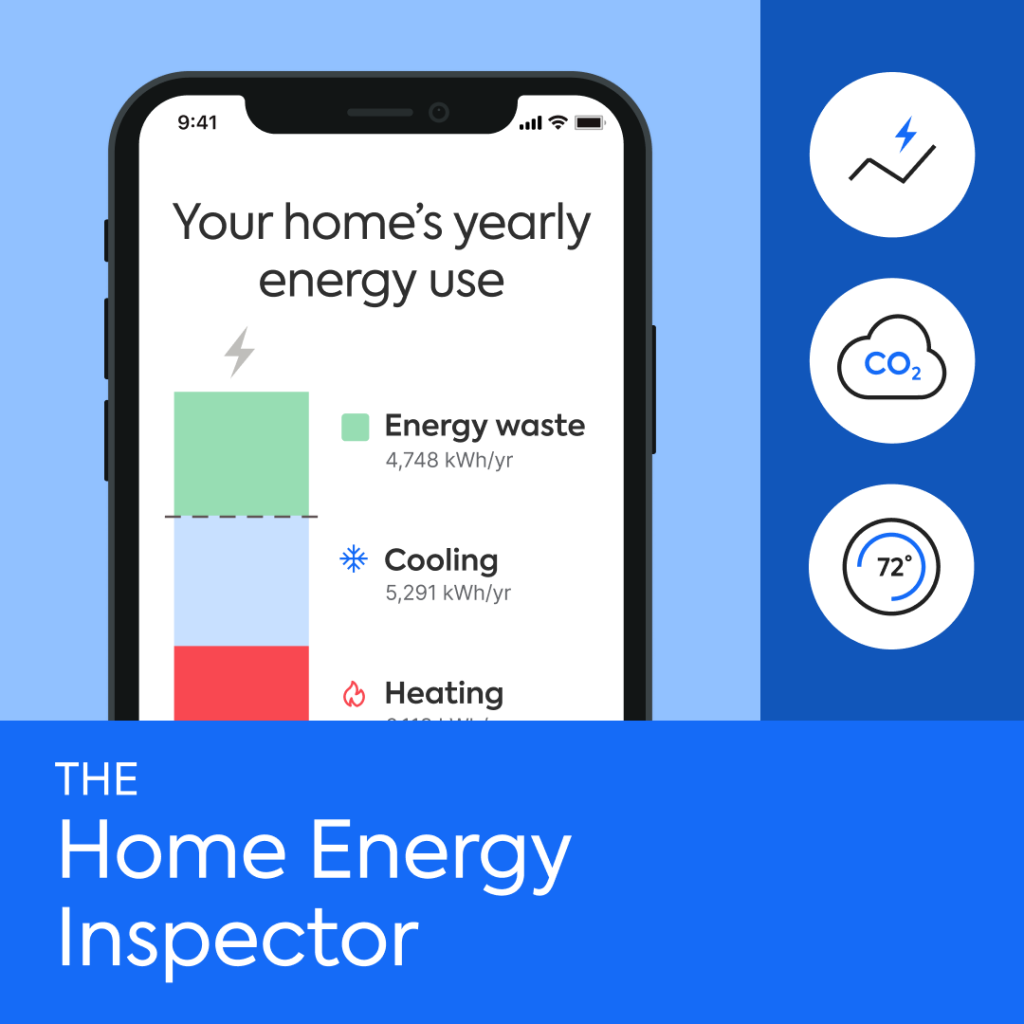American taxpayers pay the utilities for the White House. Here’s our take on how to help it waste less energy.
You may have already heard, but just in case you haven’t: The Inflation Reduction Act (IRA) of 2022 was the most significant legislation to combat climate change that the U.S. has ever passed.
It opened up billions of dollars in financial incentives for Americans to make their homes more energy efficient.
But what about the White House itself? Is it energy efficient?
Or is it drafty, stuffy, too cold, or too hot? What about installing heat pumps within the over-200-year-old building and its additions?
Let us introduce ourselves: We’re Sealed, and we’re home energy and comfort experts. And for fun, we did a deep dive remote energy assessment on the White House’s insulation, air sealing, and HVAC systems.
The efficiency of the White House is surely a project that requires an expert evaluation—one worthy of the Presidential “Sealed” of approval we hope. (See what we did there? Pun definitely intended.)
After all, the White House is a historic building that often doesn’t come up in everyday conversation, but taxpayers do pay for the utilities there… and the utilities in every one of the over 8000 federal buildings that the US owns or leases (1). So this stuff matters!
Table of contents
- Key White House energy efficiency home improvements over the years
- How buildings lose energy efficiency over time
- How to stop the energy waste at the White House
- Does the White House use heat pumps?
- Get a free expert energy assessment if your house qualifies
Key takeaways
- US taxpayers pay for the White House’s utilities—and all the other federal buildings, too—so using energy wisely is a matter of national budget.
- The same things that cause big energy waste in a historic federal building cause energy waste in your home, too.
- In our experience working with hundreds of homes, we’ve found that air sealing, high-performance insulation upgrades, and heat pump appliances can cut energy waste by up to 50%. Get these upgrades at no upfront cost if your house qualifies.
- The White House Administration is encouraging Americans to invest in efficiency and even go all-electric through new home energy rebates under the Inflation Reduction Act. But has the Administration “electrified” its own building? Find out below.
US taxpayers pay for the White House’s utilities—and all the other federal buildings, too—so using energy wisely is a matter of national budget.
Key White House energy efficiency home improvements over the years
Over time, the White House has made crucial upgrades and improvements to both modernize the building and increase energy efficiency, including:
- Low-flow plumbing upgrades to conserve water
- Energy efficient lighting upgrades
- HVAC upgrades
- The installation of solar panels
But here’s the thing: Just because a house (or our nation’s presidential home) has solar panels doesn’t mean it’s energy efficient.
And simply updating your lightbulbs or appliances to newer versions won’t eliminate the biggest sources of energy waste in your home.
Let’s cover why.
Just because the White House has solar panels doesn’t mean it’s energy efficient.

How buildings lose efficiency: The biggest energy wasters in The White House are in your home, too
The biggest source of energy waste in a residential building isn’t the windows. And it’s not the lighting, either.
It’s heating and cooling—especially if you’re paying to heat and cool an under-insulated home that has a bunch of air leaks.
Older buildings usually have crumbly, outdated, and insufficient insulation hidden in the walls and attics—if any insulation at all!—and also suffer from a leaky building envelope (aka, the barrier that keeps outside air out and inside air in).
Buildings shift over time, and gaps, holes, and open seams can form leading to airflow problems. Learn about finding home air leaks here.
This unfortunate combo causes heating and cooling systems to wear out quickly—and over-consume energy.
So, even if you upgrade to newer windows and all-LED light bulbs, you won’t be tackling the biggest energy-waster in a building (again, the biggest energy waster in a home is heating and cooling… especially if your home doesn’t have the insulation it needs).
Even if you upgrade to newer windows and all-LED light bulbs, you won’t be tackling the biggest energy-waster.
Plus, solar panels and energy efficiency improvements are related, but they’re two separate upgrades.
If you upgrade to solar panels without improving the overall efficiency of a house, you’re just wasting energy in a cleaner way.
Want to learn more? Read What to know about solar panels.
And while we haven’t slept in the White House ourselves (still waiting on an invite over here), older homes tend to have very serious temperature control and comfort issues if the above problems aren’t addressed.
Even though airflow, insulation, and HVAC issues are the biggest contributors to energy waste in the home, heating and cooling systems are also one of the big advances that make modern living more comfortable.
Should we all revert back to living like the 1800s, all while suffering through hotter summers and colder winters, just to save energy?
Nah.
Instead, we can fix these wasteful problems with proper weatherization, insulation, and super-efficient heat pump upgrades.
So let’s do it—using the White House as an example.
51% of your home’s energy consumption is dedicated to heating and cooling on average.
U.S. Energy Information Administration

How to stop wasting energy at the White House
Here’s what we’re gonna do: Our expert team at Sealed performed a remote home energy assessment of the White House based on this cheeky Zillow listing.
There are a few key areas that need to be addressed in any existing house to optimize energy conservation:
- Whole-house weatherization
- Insulation upgrades, with a focus on the attic
- Water heating methods
- Heating and cooling systems
First up? Let’s tackle weatherization issues.
Weatherization
It’s rumored that building envelope improvements to the White House were made in 2014, but we couldn’t locate published confirmation of this possibly top-secret project.
But even if some improvements were made in the last decade, depending on the materials used, an energy audit could help determine what—if any—updates are needed.
Basic weatherstripping around windows and doors should be checked once every year and replaced every few years.
Weatherstripping around windows and doors should be checked once every year and replaced every few years.
The White House is an old building, so our team is sure it could use some caulking and air sealing around windows and doors.
The windows may be bulletproof, but that doesn’t mean they’re heat-loss proof! And of course, the Secret Service may not let a caulking gun through, so everyone will need to get clearance for the project ahead of time. (Again: We love a good joke.)
Plus, any secret passages and entryways should be well weatherstripped and remain closed at all times to maintain the utmost efficiency.
Insulation solutions
The most powerful home insulation solutions take a top-to-bottom approach, and it’s the same for the White House. We’ll tackle three key areas:
- Exterior wall insulation upgrades
- Basement insulation fixes
- Attic insulation improvements
Exterior wall insulation upgrades
Not every single wall of a house needs added insulation, but you can bet the exterior ones sure do!
Any exterior walls of the White House (that are not solid steel, of course!) should be dense-packed with cellulose.
Cellulose insulation in exterior walls would not only conserve energy and make the house more comfortable, but it would also provide some fire protection and dampen sound to help keep our country’s special secrets intact.
Basement insulation fixes
Next up? The basement. Most homeowners overlook basement and crawlspace areas when it comes to insulation improvements.
We do know the basement of the White House is finished and is a shelter, so rim joist insulation is out.
But our team of experts notes that any unfinished concrete walls could use some foam board to increase the overall efficiency of the President’s house.
Most homeowners overlook basement and crawlspace areas when it comes to insulation improvements.
Attic insulation improvements
To complete our top-to-bottom insulation approach, we need to tackle the attic—including any hidden or forgotten ones.
Not surprisingly, very little info is available online about air leaks and penetrations in the attic of the White House.
But a building’s attic is one of the most important areas to insulate and air seal correctly to improve overall comfort and energy efficiency.
The attic is one of the most important areas to insulate and air seal correctly to improve overall comfort and energy efficiency.
The White House has a flat roof, but there is surely some amount of attic space for ductwork and other utilities. And it’s possible there are some hidden attics in this historic building that need insulation upgrades, too.
Since spray foam installation requires members of a household to vacate for at least 24 hours, it’s unlikely to expect the entire White House to be empty, so spray foam insulation isn’t the best fix here.
As an alternative, our team would most likely want to air seal and use loose-fill cellulose in the attic. Plywood platforms could even be installed over the cellulose for future access to mechanical equipment or ductwork in this portion of the building.
Efficient water heating
Water heating makes up about 19% of residential energy consumption on average (2).
And if you’re hosting honorable guests from across the globe at the White House, you do not want to run into the embarrassment of “running out of” hot water.
The efficient solution? A hybrid heat pump water heater.
Heat pump water heaters can be up to 50% more efficient than natural gas water heaters (3). And they’re more efficient (and have more reliable, quick, ready-to-use hot water) than tankless.
When you’re entertaining global dignitaries, the comforts of modern life (ie, fresh hot water) are a must-have.
When you’re entertaining global dignitaries, the comforts of modern life (ie, fresh hot water) are a must-have.
So, if the White House converts to heat pump water heaters, it’ll get the best of both worlds: The joy of comfortable, hot showers and the benefits of energy conservation at the same exact time.

Heat pump heating and cooling systems at the White House
To make our whole-home energy efficiency upgrades of the White House complete, all ductwork should be sealed to prevent heat loss (and to also stop Tom Cruise’s Mission Impossible character from entering the building).
And if the White House hasn’t made the switch to energy efficient heat pumps, well, it’s about time… especially since the US government is incentivizing American homeowners to do so through the IRA of 2022 and planning to convert all federal buildings to heat pumps where possible (4). Learn all about heat pump tax credits and rebates here.
The US government is planning to convert all federal buildings to heat pumps where possible.
The Federal Building Performance Standard, December 2022
What kind of heat pump should the White House go with?
Well, air source heat pumps would require the least invasive installation for a treasured historic property and grounds like the White House.
Plus, air source heat pumps offer both ducted and ductless heating and cooling options, which allow for flexible installation configurations.
And while geothermal heat pumps are a neat technology, they require an invasive installation, which isn’t always the best option for a historic property. Read more about geothermal vs air source heat pumps here.
With a combination of a centrally ducted heat pump system—if the ductwork is in excellent condition or is easy-access for repairs—along with strategically placed mini splits that allow for finer temperature control in offices and guest rooms, the President’s Palace would be in great shape to stay comfy and conserve more energy year round.
Wait—why doesn’t the White House use heat pumps?
We did plenty of digging, and it’s unclear to us if the White House has officially switched over to all-electric, super-efficient heat pump HVAC yet.
We want to know: If it hasn’t already, why hasn’t the White House fully converted to heat pumps?
The federal incentives under the IRA—and even local utility rebates and efficiency programs—encourage homeowners to convert to heat pumps.
And sales of heat pumps in the US have surpassed gas furnaces in 2022 (5).
Not to mention, many notable buildings use them, including Buckingham Palace.
While we don’t know the answer to this question (yet—but if the White House press secretary wants to get back to us, we’re all ears)… there are a few myth-based reasons the everyday homeowner is hesitant to switch to heat pumps:
- Myth 1: Heat pumps don’t work well to heat your house in cold temperatures.
- Myth 2: Heat pumps require invasive installation.
Myth 1: Heat pumps don’t work well in cold temperatures.
This is an old myth that just keeps on persisting, despite plenty of evidence otherwise.
The White House needs to be ready for any weather all year long (and D.C. winters can get pretty cold!). But cold climate air source heat pumps are rated to perform at -13 degrees, with some newer developed models performing down to -22 degrees—and they may perform at more severe negative temps if the home has been air sealed and properly insulated.
Cold climate air source heat pumps are rated to perform at -13 degrees, with some rated to perform down to -22 degrees.
In fact, some modern air source heat pumps are being developed right now that can withstand even lower winter temperatures. (That’s amazing!)
While this myth is clearly busted, there is another option for homeowners still a little hesitant about all-electric heat humps: a dual-fuel HVAC system.
But, we at Sealed believe going all-electric is the future. And let’s be honest: plenty of days in Virginia are over -13. In fact, the coldest winter day on record for Washington, D.C., was -15 degrees… and that was over 140 years ago in 1881 (6).
So, relying on heat pumps for all of the -12 and up days (and years) would benefit the White House—and taxpayers—with huge efficiency gains.
Myth 2: Heat pumps require invasive installation.
This is simply not true (heat pumps are incredibly flexible in their installation configurations!).
The White House is a vital historic building, and preservation is key. But heat pumps can use existing ductwork… or forgo ductwork entirely!
And if the White House wants to preserve that picture-perfect lawn and gorgeous green grounds, it can skip the invasive install of a geothermal heat pump and go with an air source system instead.
Want an expert energy assessment for your own home?
We’ve got good news: Your house doesn’t have to be a famous, priceless historic landmark to be eligible for a custom home upgrade plan like this one.
No matter the age or size or shape of your home, it can feel amazing (and waste less energy!) year round.
In fact, if you’re eligible, you could get a custom (free!) remote home energy assessment with Sealed. It only takes two minutes to see if your house qualifies.
If you choose to get home energy upgrades with Sealed, you’ll get a completely custom plan from experts with years of experience in air circulation and climate control. We don’t do cookie-cutter solutions, either.
You’ll get a proposal that’s tailored to your situation and the unique needs of your home. (We even do our best to use the type of materials you’d like to use!)
We’ll put together the plan, hire expert contractors, help you understand local rebates you’re eligible for, and make sure that everything gets done right—eligible local rebates included. Learn how the Sealed payment plan compares.
All you need to do? Enjoy a house that feels amazing and conserves more energy year round.
No matter the age or size or shape of your home, it can feel amazing (and waste less energy!) year round.

Ready to crunch the numbers?
Check out our home energy usage calculator to see where you could cut energy waste BIG TIME.